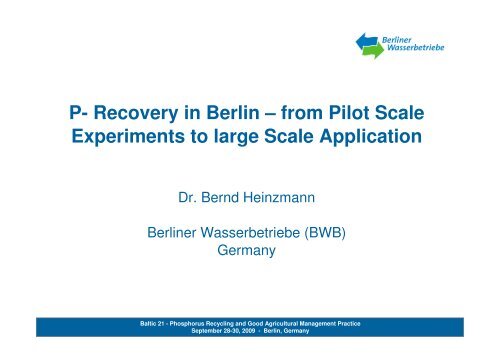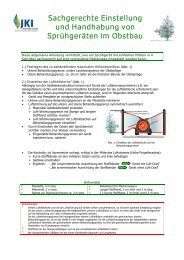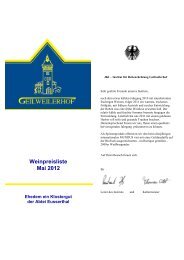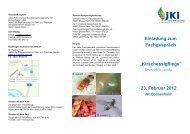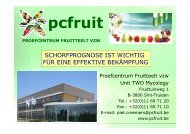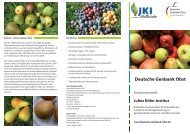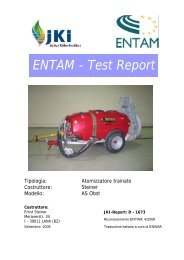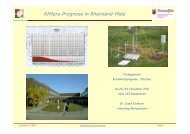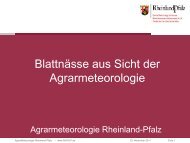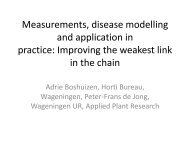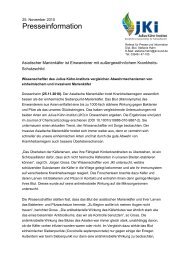P- Recovery in Berlin – from Pilot Scale Experiments to large Scale ...
P- Recovery in Berlin – from Pilot Scale Experiments to large Scale ...
P- Recovery in Berlin – from Pilot Scale Experiments to large Scale ...
Create successful ePaper yourself
Turn your PDF publications into a flip-book with our unique Google optimized e-Paper software.
P- <strong>Recovery</strong> <strong>in</strong> Berl<strong>in</strong> <strong>–</strong> <strong>from</strong> <strong>Pilot</strong> <strong>Scale</strong><br />
<strong>Experiments</strong> <strong>to</strong> <strong>large</strong> <strong>Scale</strong> Application<br />
Dr. Bernd He<strong>in</strong>zmann<br />
Berl<strong>in</strong>er Wasserbetriebe (BWB)<br />
Germany<br />
Baltic 21 - Phosphorus Recycl<strong>in</strong>g and Good Agricultural Management Practice<br />
September 28-30, 2009 - Berl<strong>in</strong>, Germany
Content<br />
1. Formation of Incrustations<br />
<strong>in</strong> the Sludge Cha<strong>in</strong><br />
2. Measures for Incrustation Prevention<br />
3. Measures for Phosphorus <strong>Recovery</strong><br />
4. The Cooperation Project with TU Berl<strong>in</strong><br />
5. Assessment of the<br />
MAP Precipitation Product<br />
6. Summary<br />
Baltic 21 - Phosphorus Recycl<strong>in</strong>g and Good Agricultural Management Practice<br />
September 28-30, 2009 - Berl<strong>in</strong>, Germany
1. Formation of Incrustations<br />
<strong>in</strong> the Sludge Treatment<br />
� The wastewater purification process is used<br />
with an enhanced biological phosphorus removal and<br />
concentrated streams of digested sludge<br />
� Favours the formation of <strong>in</strong>crustations dur<strong>in</strong>g sludge treatment<br />
� Spontaneous release or degass<strong>in</strong>g of carbon dioxide of the over<br />
saturation of the digested sludge and the process water (centrate of the<br />
digested sludge)<br />
� These <strong>in</strong>crustations were the cause of a lot of operational problems!<br />
Baltic 21 - Phosphorus Recycl<strong>in</strong>g and Good Agricultural Management Practice<br />
September 28-30, 2009 - Berl<strong>in</strong>, Germany
Examples of Incrustation Problems <strong>in</strong> the<br />
WWTP Waßmannsdorf<br />
Objective: Prevention of <strong>in</strong>crustations<br />
� safe operation of the sludge treatment process<br />
digester<br />
He<strong>in</strong>zmann and Engel (2003)<br />
80 mm diameter bend jo<strong>in</strong>t of pump 2 after 319<br />
operat<strong>in</strong>g hours and <strong>in</strong>take aperture after 180<br />
operation hours of the centrate pump<strong>in</strong>g station<br />
Baltic 21 - Phosphorus Recycl<strong>in</strong>g and Good Agricultural Management Practice<br />
September 28-30, 2009 - Berl<strong>in</strong>, Germany
Studies and Trials Undertaken <strong>to</strong> Identify and<br />
Further <strong>to</strong> Prevent the Incrustation Problems<br />
<strong>in</strong> the WWTP Waßmannsdorf<br />
• Chemical and structural analysis of the crystall<strong>in</strong>e matter:<br />
→ Insoluble, crystall<strong>in</strong>e white MAP deposits with small portions of different<br />
calcium phosphate compounds<br />
• Technical labora<strong>to</strong>ry tests <strong>to</strong> study the phosphorus dynamics <strong>in</strong> anaerobic<br />
sludge treatment<br />
(chemistry and k<strong>in</strong>etics of phosphorus precipitation dur<strong>in</strong>g digestion)<br />
• Trials on the degass<strong>in</strong>g of CO 2 due <strong>to</strong> aeration of the digested sludge<br />
• Labora<strong>to</strong>ry studies that dealt with the <strong>in</strong>duced precipitation of struvite and<br />
calcium phosphates by means of aerat<strong>in</strong>g digested sludge which leads <strong>to</strong><br />
degass<strong>in</strong>g of CO 2 , thus <strong>in</strong>creas<strong>in</strong>g pH value<br />
Baltic 21 - Phosphorus Recycl<strong>in</strong>g and Good Agricultural Management Practice<br />
September 28-30, 2009 - Berl<strong>in</strong>, Germany
2. Measures for Incrustation Prevention<br />
mixed raw-sludge<br />
two stage high rate digestion<br />
anti-<strong>in</strong>crustation agent<br />
MgCl 2<br />
digested sludge<br />
s<strong>to</strong>rage tank<br />
anti-<strong>in</strong>crustation agent<br />
Baltic 21 - Phosphorus Recycl<strong>in</strong>g and Good Agricultural Management Practice<br />
September 28-30, 2009 - Berl<strong>in</strong>, Germany<br />
digested sludge<br />
MAP<br />
air<br />
air<br />
centrifuge<br />
centrate<br />
dewatered sludge
3. Measures for Phosphorus <strong>Recovery</strong><br />
• Partial separation of the MAP by<br />
sedimentation <strong>in</strong> the digested<br />
sludge s<strong>to</strong>rage tank of the<br />
WWTP<br />
• After a period of 3 months<br />
around 30 <strong>to</strong>ns of MAP are<br />
removed <strong>from</strong> the bot<strong>to</strong>m by a<br />
vacuum truck<br />
• Disposal<br />
(costs around 140 euro / <strong>to</strong>ns)<br />
• Clean<strong>in</strong>g is necessary before<br />
phosphorus recovery<br />
Baltic 21 - Phosphorus Recycl<strong>in</strong>g and Good Agricultural Management Practice<br />
September 28-30, 2009 - Berl<strong>in</strong>, Germany
4. The Cooperation Project with TU Berl<strong>in</strong>,<br />
Chair of Chemical & Process Eng<strong>in</strong>eer<strong>in</strong>g<br />
Ma<strong>in</strong> Objectives:<br />
• optimum dimension<strong>in</strong>g of the digested sludge<br />
s<strong>to</strong>rage tank for complete precipitation and<br />
separation of MAP:<br />
→ A high yield of precipitated crystals for a<br />
maximum P-recovery<br />
→ Enhanced crystal separation <strong>from</strong> digested<br />
sludge<br />
Methods<br />
• Lab scale research for optimiz<strong>in</strong>g relevant<br />
parameters like aeration rate, Mg-dos<strong>in</strong>g,<br />
geometric dimension<strong>in</strong>g, s<strong>to</strong>ichiometric ratio of<br />
crystallization partners, yield of MAP<br />
• Batch and cont<strong>in</strong>uously pilot plant trials<br />
Baltic 21 - Phosphorus Recycl<strong>in</strong>g and Good Agricultural Management Practice<br />
September 28-30, 2009 - Berl<strong>in</strong>, Germany<br />
Stumpf (2009)
<strong>Pilot</strong> Plant Airlift Reac<strong>to</strong>r:<br />
Efficient MAP-Precipitation<br />
Residual concentration cPO4-P [mg L-1]<br />
300<br />
200<br />
100<br />
0<br />
HRT = 8h cPO4-P pH<br />
Digested sludge<br />
0 1 2 3 4 5 6 7 8<br />
time [h]<br />
• About 90 - 95 % of phosphorus could be precipitated as MAP<br />
• An airlift reac<strong>to</strong>r is suitable for an enhanced MAP-precipitation<br />
9,0<br />
8,5<br />
8,0<br />
7,5<br />
7,0<br />
6,5<br />
6,0<br />
pH-value<br />
Baltic 21 - Phosphorus Recycl<strong>in</strong>g and Good Agricultural Management Practice<br />
September 28-30, 2009 - Berl<strong>in</strong>, Germany<br />
Operational parameters:<br />
- Reac<strong>to</strong>r volume<br />
45 L<br />
- Aeration rate<br />
500 L h -1<br />
- n PO4-P : n Mg = 1:1<br />
- Hydraulic residence<br />
time (HRT) = 8 h
<strong>Pilot</strong> Plant Airlift Reac<strong>to</strong>r:<br />
Particle Size Distribution of MAP by Siev<strong>in</strong>g<br />
Frequency distribution [%]<br />
50<br />
40<br />
30<br />
20<br />
10<br />
0<br />
MAP <strong>from</strong> digested sludge before<br />
pilot plant trials<br />
MAP <strong>from</strong> digested sludge after<br />
pilot plant trials<br />
0 100 200 300 400 500 600 700 800<br />
size [µm]<br />
• Similar results of the digested sludge before and after pilot plant trials<br />
• Slight trend <strong>to</strong> more MAP due <strong>to</strong> precipitation and further growth of the crystals<br />
• Average crystal sizes are still <strong>to</strong>o small for a maximum separation<br />
Baltic 21 - Phosphorus Recycl<strong>in</strong>g and Good Agricultural Management Practice<br />
September 28-30, 2009 - Berl<strong>in</strong>, Germany
P-Balance <strong>in</strong> Batch Operation <strong>–</strong> Current<br />
Situation at WWTP Waßmannsdorf<br />
Total-P <strong>in</strong> percent <strong>in</strong> digested sludge [%]<br />
100<br />
90<br />
80<br />
70<br />
60<br />
50<br />
40<br />
30<br />
20<br />
10<br />
0<br />
P-content <strong>in</strong><br />
sludge<br />
BWB current digested sludge s<strong>to</strong>rage tank<br />
TU pilot plant airlift reac<strong>to</strong>r<br />
ortho-P <strong>in</strong><br />
digested sludge<br />
P-precipitated P-separated<br />
Baltic 21 - Phosphorus Recycl<strong>in</strong>g and Good Agricultural Management Practice<br />
September 28-30, 2009 - Berl<strong>in</strong>, Germany
P-Balance <strong>in</strong> Cont<strong>in</strong>uous Operation<br />
Total-P <strong>in</strong> percent <strong>in</strong> digested sludge [%]<br />
100<br />
90<br />
80<br />
70<br />
60<br />
50<br />
40<br />
30<br />
20<br />
10<br />
0<br />
P-content <strong>in</strong><br />
sludge<br />
BWB optimized digested sludge s<strong>to</strong>rage tank<br />
(not yet <strong>in</strong> operation)<br />
TU pilot plant airlift reac<strong>to</strong>r<br />
ortho-P <strong>in</strong><br />
digested sludge<br />
P-precipitated P-separated<br />
Baltic 21 - Phosphorus Recycl<strong>in</strong>g and Good Agricultural Management Practice<br />
September 28-30, 2009 - Berl<strong>in</strong>, Germany<br />
?
Design<strong>in</strong>g of an Optimized<br />
Digested Sludge S<strong>to</strong>rage Tank<br />
Current:<br />
Optimized:<br />
Stumpf et al. (2009)<br />
Objective:<br />
• Optimiz<strong>in</strong>g the MAP precipitation<br />
• Improvement of the MAP<br />
separation<br />
� Circulation - flow caused by air<br />
<strong>in</strong>jection; mix<strong>in</strong>g<br />
� Stripp<strong>in</strong>g the CO 2<br />
� pH rises, precipitated MAP as<br />
crystals<br />
� MAP is released through a coneshaped<br />
bot<strong>to</strong>m<br />
Baltic 21 - Phosphorus Recycl<strong>in</strong>g and Good Agricultural Management Practice<br />
September 28-30, 2009 - Berl<strong>in</strong>, Germany
Pictures of the Optimized Digested<br />
Sludge S<strong>to</strong>rage Tank under Construction<br />
at the WWTP Waßmannsdorf<br />
Baltic 21 - Phosphorus Recycl<strong>in</strong>g and Good Agricultural Management Practice<br />
September 28-30, 2009 - Berl<strong>in</strong>, Germany
Further Separation of the MAP <strong>from</strong> the<br />
Digested Sludge<br />
• Hydro-cyclone<br />
• Cyclone separa<strong>to</strong>r with immersed spiral pipe<br />
• Centrifuge, e.g. :<br />
- Sedimentation <strong>in</strong>struments; Vertical centrifuge<br />
(discont<strong>in</strong>uous centrifuge); Horizontal centrifuge<br />
(with/ without rotation - discont<strong>in</strong>uous centrifuge);<br />
Shear<strong>in</strong>g centrifuge (cont<strong>in</strong>uous centrifuge) and<br />
Sieves screw extrusion centrifuge (cont<strong>in</strong>uous<br />
centrifuge)<br />
• Sieves:<br />
- Rotary type screen; Upstream classification;<br />
Bended sieves and Screw extrusion press<br />
Baltic 21 - Phosphorus Recycl<strong>in</strong>g and Good Agricultural Management Practice<br />
September 28-30, 2009 - Berl<strong>in</strong>, Germany
Trials for further Separation of the MAP <strong>from</strong><br />
the Digested Sludge us<strong>in</strong>g Hydro-cyclones<br />
� A centrifugal separation by means of hydro-cyclones<br />
� MAP crystal density is 1.7 kg/dm3<br />
� Particle size distribution is 95 % > 0.063 mm<br />
►To achieve separation of particles > 0.05 mm<br />
Supernatant<br />
outflow<br />
Influent<br />
Base<br />
outflow<br />
Baltic 21 - Phosphorus Recycl<strong>in</strong>g and Good Agricultural Management Practice<br />
September 28-30, 2009 - Berl<strong>in</strong>, Germany
Clean<strong>in</strong>g of the separated MAP Precipitation<br />
Product<br />
� Investigation of an optimal clean<strong>in</strong>g or treatment<br />
process for the separated MAP precipitation<br />
product by<br />
� Wash<strong>in</strong>g<br />
� Belt filter squeezer<br />
� Dry<strong>in</strong>g<br />
Outflow with high concentrated MAP<br />
of hydro-cyclone<br />
Baltic 21 - Phosphorus Recycl<strong>in</strong>g and Good Agricultural Management Practice<br />
September 28-30, 2009 - Berl<strong>in</strong>, Germany
Microscope Pho<strong>to</strong>s of MAP Crystals <strong>in</strong><br />
the Base Outflow of the Hydro-Cyclone<br />
Crystals with typical<br />
orthorhombic shape<br />
Baltic 21 - Phosphorus Recycl<strong>in</strong>g and Good Agricultural Management Practice<br />
September 28-30, 2009 - Berl<strong>in</strong>, Germany
Large <strong>Scale</strong> Trials for Clean<strong>in</strong>g MAP <strong>from</strong><br />
Digested Sludge <strong>in</strong> a Grid Wash<strong>in</strong>g Tank<br />
Baltic 21 - Phosphorus Recycl<strong>in</strong>g and Good Agricultural Management Practice<br />
September 28-30, 2009 - Berl<strong>in</strong>, Germany
Results of Wash<strong>in</strong>g Trials<br />
• Decreas<strong>in</strong>g TOC-concentration by <strong>in</strong>creas<strong>in</strong>g water <strong>in</strong>flow<br />
• Fluidized-bed height not relevant for an efficient clean<strong>in</strong>g of MAP-crystals<br />
Baltic 21 - Phosphorus Recycl<strong>in</strong>g and Good Agricultural Management Practice<br />
September 28-30, 2009 - Berl<strong>in</strong>, Germany
Content<br />
1. Formation of Incrustations<br />
<strong>in</strong> the Sludge Cha<strong>in</strong><br />
2. Measures for Incrustation Prevention<br />
3. Measures for Phosphorus <strong>Recovery</strong><br />
4. The Cooperation Project with TU Berl<strong>in</strong><br />
5. Assessment of the<br />
MAP Precipitation Product<br />
6. Summary<br />
Baltic 21 - Phosphorus Recycl<strong>in</strong>g and Good Agricultural Management Practice<br />
September 28-30, 2009 - Berl<strong>in</strong>, Germany
Comparison of Nutrients <strong>in</strong> the washed and unwashed MAP<br />
Precipitation Product, after the Separation by Hydro-Cyclone,<br />
with m<strong>in</strong>imum Contents of different Fertilisers def<strong>in</strong>ed by the<br />
German Fertiliser Regulation<br />
Content [%]<br />
20<br />
15<br />
10<br />
5<br />
0<br />
Unwashed MAP after hydro-cyclone<br />
Washed MAP after hydro-cyclone<br />
Superphosphate<br />
Dicaliumphosphate with magnesium<br />
NP-fertilizer<br />
P 2 O 5 N <strong>to</strong>tal MgO<br />
Baltic 21 - Phosphorus Recycl<strong>in</strong>g and Good Agricultural Management Practice<br />
September 28-30, 2009 - Berl<strong>in</strong>, Germany<br />
Supernatant Überlauf Unterlauf Base<br />
outflow outflow<br />
Influent Zulauf
Comparison of Heavy Metal Content<br />
(<strong>in</strong> % based on P) <strong>in</strong> digested Sludge and<br />
<strong>in</strong> unwashed MAP Precipitation Product<br />
% Heavy metal / kg Phosphorus<br />
2,5<br />
2<br />
1,5<br />
1<br />
0,5<br />
0<br />
digested Sludge<br />
im Faulschlamm<br />
MAP<br />
im MAP<br />
Lead Chrome Copper Nickel Z<strong>in</strong>c Cadmium Mercury<br />
Baltic 21 - Phosphorus Recycl<strong>in</strong>g and Good Agricultural Management Practice<br />
September 28-30, 2009 - Berl<strong>in</strong>, Germany
Phosphorus - Availability with regard <strong>to</strong><br />
German Ryegrass <strong>–</strong> Lolium perenne<br />
Investigations of the phosphorus availability<br />
of the MAP precipitation product compared <strong>to</strong><br />
synthetic MAP and calcium phosphate:<br />
→ two soils with a pH-value of 6.6 und 7.1<br />
→ special k<strong>in</strong>d of grass German Ryegrass<br />
(Lolium perenne):<br />
• Good mobility of phosphorus <strong>in</strong> the fertilized<br />
soil<br />
• Good availability<br />
• Satisfy<strong>in</strong>g growth<br />
(Richards and Johns<strong>to</strong>n, 2001)<br />
Baltic 21 - Phosphorus Recycl<strong>in</strong>g and Good Agricultural Management Practice<br />
September 28-30, 2009 - Berl<strong>in</strong>, Germany
6. Summary<br />
� Process for an <strong>in</strong>duced precipitation of MAP is applied<br />
● Prevention of further <strong>in</strong>crustations<br />
● Fix<strong>in</strong>g of significant amounts of phosphorus <strong>in</strong> the MAP<br />
� Substantial reduction of the rema<strong>in</strong><strong>in</strong>g P-load <strong>in</strong> the wastewater purification<br />
process<br />
� Partial separation by gravity of the MAP already <strong>in</strong> the digested sludge<br />
s<strong>to</strong>rage tank<br />
� Assessment of the MAP precipitation product for reuse as fertilizer:<br />
nutrients, pollutants, (solubility) and plant availability<br />
� Process optimization before a cont<strong>in</strong>uous technical application <strong>in</strong> the<br />
WWTP Waßmannsdorf<br />
Baltic 21 - Phosphorus Recycl<strong>in</strong>g and Good Agricultural Management Practice<br />
September 28-30, 2009 - Berl<strong>in</strong>, Germany
� The Cooperation Project with TU Berl<strong>in</strong><br />
(Chair of Chemical & Process Eng<strong>in</strong>eer<strong>in</strong>g)<br />
for optimal dimension<strong>in</strong>g of the digested sludge s<strong>to</strong>rage tank<br />
for cont<strong>in</strong>uously complete precipitation and separation of MAP<br />
� Optimal design of the digested sludge s<strong>to</strong>rage tank regard<strong>in</strong>g <strong>to</strong> air<br />
<strong>in</strong>jection, aeration rate, the flow pattern, geometric dimension<strong>in</strong>g, MAP<br />
precipitation (crystallisation and growth) and Mg-dos<strong>in</strong>g, s<strong>to</strong>ichiometric ratio<br />
of crystallization partners, yield of MAP<br />
� Construction of the optimized sludge s<strong>to</strong>rage tank<br />
� Further MAP separation <strong>in</strong> a subsequent second step,<br />
e.g. by hydro - cyclone<br />
� Optimal clean<strong>in</strong>g for the separated MAP precipitation product by wash<strong>in</strong>g<br />
Baltic 21 - Phosphorus Recycl<strong>in</strong>g and Good Agricultural Management Practice<br />
September 28-30, 2009 - Berl<strong>in</strong>, Germany
Thank you for your attention!<br />
Baltic 21 - Phosphorus Recycl<strong>in</strong>g and Good Agricultural Management Practice<br />
September 28-30, 2009 - Berl<strong>in</strong>, Germany


